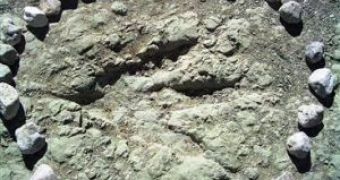Mexico has a special symbolism when talking about dinosaurs, as this is the place where a giant asteroid hit the Earth 65 million years ago, triggering the extinction of all dinosaurs (in fact 85 % of the land species and 90 % of the marine species disappeared).
The place of the impact was found onto the Yucatan Peninsula, the Chicxulub crater, which is half submerged under the sea.
Many dinosaur fossils were found, including big carnivorous, huge herbivorous sauropods (with long necks and Tails, small heads and elephant-like feet) and duck-billed vegetarians.
And not only bones, but also fossilized dinosaur skin.
Recently, a Mexican man has added to the Mexican dinosaur records dozens of dinosaur footprints found to be 110 million years old, along the banks of a dried river.
"The footprints, found by a local resident in a desert region in central Mexico, belonged to three prehistoric species that came to drink water in the area, once a swampy zone close to the sea," said biologist Oscar Polaco.
"More studies needed to be done to determine what species of dinosaur the fossilized prints, each one up to 24 inches (60 centimeters) across, belonged to. At the moment we can confirm these are footprints that belong to dinosaurs that lived during the early Cretaceous (period)," added Polaco.
The early Cretaceous era started roughly 144 million years ago, following the Jurassic period (the middle dinosaur era).
The Cretaceous period is the last dinosaur era, lasting till the meteorite impact.
The footprints are located across the land on the property of a local cooperative, and the members have made a fence surrounding the site to protect it.
In 2006, scientists found 30 other dinosaur prints in the same zone, famous for the large numbers of fossils discovered.
The 2006 prints were of a 66-foot-long (20-meter-long) sauropod dinosaur, named apatosaurus (brontosaurus), weighing 30-40 tones.
Photo credit: INAH.

 14 DAY TRIAL //
14 DAY TRIAL //